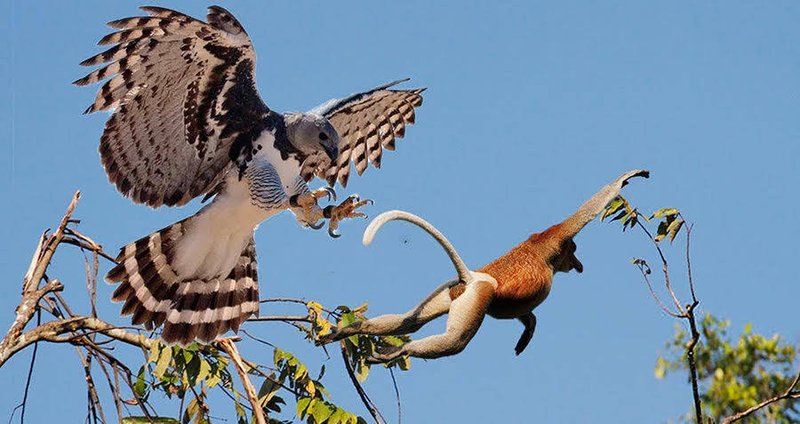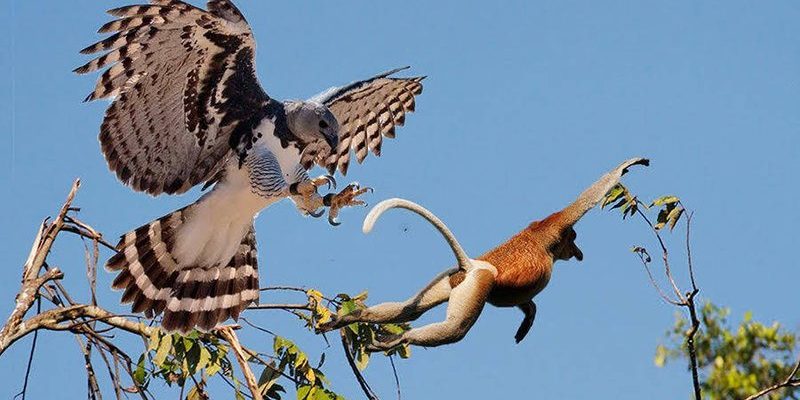
Imagine a predator that can take on prey as big as a sloth or a monkey. The Harpy Eagle is known for its strength, agility, and adaptability in its hunting strategies. Watching one in action is like witnessing nature’s own ballet, blending grace with raw power. Let’s dive into the fascinating world of the Harpy Eagle and explore how it flies and hunts, revealing the intricate dance of survival in the wild.
What Makes the Harpy Eagle Unique?
The Harpy Eagle is a colossal bird, typically weighing between 6 to 10 kilograms (13 to 22 pounds) and boasting a wingspan that can reach up to 2.2 meters (about 7.2 feet). This size alone distinguishes it from other eagles. But it’s not just about size; it’s also about their distinctive features—thick legs, strong talons, and a strikingly beautiful crest of feathers on their head.
Their plumage is a mix of dark gray and white, which helps them blend into the dappled lighting of the forest canopy. With such excellent camouflage, you might not even notice one perched above you until it’s too late! Besides their appearance, their incredible visual acuity—the ability to see sharp images from great distances—means they can spot prey even when hidden deep within the tree branches.
Moreover, the Harpy Eagle’s strong beak is specifically adapted for tearing flesh, showing just how well-designed they are for their hunting lifestyle. So, when you think about their unique adaptations, it becomes clear why they hold the title of apex predator in their habitat.
Flying Techniques of the Harpy Eagle
Harpy Eagles possess some impressive flying abilities that allow them to navigate the complex layers of the rainforest. They’re not just powerful fliers; they are exceptionally adept at maneuvering through dense vegetation. This is where their broad wings come into play. They enable the eagle to generate lift even in the tightest of spaces.
When hunting, Harpy Eagles use a technique called “soaring,” where they glide and scan the forest floor for movements. While they’re soaring, they can cover large areas without expending much energy. Think of it like a stealthy drone, quietly hovering and carefully surveying its surroundings.
Additionally, when it comes time to dive down on their prey, they can reach speeds of up to 80 km/h (about 50 mph). This combination of gliding and rapid descent makes them incredibly efficient at hunting. When you see them in action, it’s almost like they’re defying gravity, swooping down with precision and power.
The Harpy Eagle’s Hunting Style
Now, let’s talk about how these majestic birds actually hunt. The Harpy Eagle’s hunting style is nothing short of spectacular. They typically rely on a method known as ambush hunting. This means they’ll perch quietly in a tree, scanning for prey before making their move. They have a special knack for spotting movement, which allows them to time their swoops perfectly.
Once they identify their target, they use their impressive strength and sharp talons to grab it. For instance, sloths and monkeys are common prey for these eagles. Imagine a large monkey swinging through the trees—it might think it’s safe, but the Harpy Eagle is already eyeing it from above, ready to strike with unmatched speed.
After capturing their prey, Harpy Eagles will usually return to a high branch or a nest to eat. They often tear apart their catch using their powerful beak. It’s fascinating how these eagles not only have the power to capture but also the intelligence to plan their moves strategically.
Adaptations for Success
One of the most impressive things about the Harpy Eagle is its ability to adapt to its environment. Living in tropical rainforests, they face challenges like competition for food and habitat loss. However, their hunting techniques and physical adaptations allow them to thrive in this setting.
For example, they can adjust their hunting patterns based on prey availability. If a certain type of prey becomes scarce, they might target different animals or even change their hunting times to adapt. This flexibility is vital for their survival, especially in an environment that’s constantly changing.
Furthermore, their breeding behavior also shows adaptation. Harpy Eagles often build nests high in the trees, which protects their young from predators. They invest a lot of time and energy into raising their chicks, demonstrating a commitment to ensuring the next generation thrives.
The Importance of the Harpy Eagle in the Ecosystem
Harpy Eagles play a crucial role in their ecosystem. As top predators, they help maintain the balance of populations for various animal species. By keeping numbers in check, they ensure that prey species don’t overpopulate, which can lead to habitat degradation.
Furthermore, their hunting habits can indirectly affect plant life. For instance, when they prey on monkeys that feed on fruits, they help control the dispersal of seeds. This means their presence is vital not just for the animal kingdom but for the health of the forest as a whole.
However, it’s important to note that Harpy Eagles are considered vulnerable due to habitat loss and hunting. Protecting their habitats means protecting the intricate web of life they help sustain. Conservation efforts are essential to ensure these magnificent birds continue to thrive in the wild.
How to Observe Harpy Eagles in the Wild
If you’re curious about seeing Harpy Eagles in their natural habitat, there are a few key regions where you might spot them. They primarily inhabit tropical rainforests in Central and South America, particularly in countries like Brazil, Ecuador, and Panama.
When planning a trip to observe these eagles, consider visiting protected areas or national parks where they are known to reside. Being patient is key! Often, it requires sitting quietly and observing the treetops for extended periods. Bring binoculars for a closer view—this makes all the difference when trying to spot these magnificent birds against the backdrop of greenery.
Remember to respect their environment. Keep a safe distance and avoid disturbing their nesting sites, as these eagles are sensitive to human presence. You never know—if you’re lucky, you might witness the incredible flying and hunting techniques of the Harpy Eagle up close!
Wrapping It Up
The Harpy Eagle is a true marvel of the avian world. With their unique flying and hunting techniques, these birds have earned their spot as one of the most powerful predators in the rainforest. They remind us of the delicate balance in nature and the importance of conserving our wildlife.
So, the next time you think about the wonders of wildlife, remember the Harpy Eagle and its extraordinary adaptations. From their powerful talons to their impressive flying skills, they truly are a symbol of strength and beauty in the wild. By learning more about these magnificent hunters, we can appreciate and advocate for their continued existence, ensuring that future generations can also be awed by their splendor.

